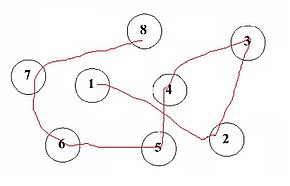Trail Making Test
| Trail Making Test | |
|---|---|
 Part A sample | |
| MeSH | D014145 |
The Trail Making Test is a neuropsychological test of visual attention and task switching. It has two parts, in which the subject is instructed to connect a set of 25 dots as quickly as possible while maintaining accuracy.[1] The test can provide information about visual search speed, scanning, speed of processing, mental flexibility, and executive functioning.[1] It is sensitive to cognitive impairment associated with dementia, including Alzheimer's disease.[2]
History
The test was created by
Method and interpretation
The task requires the subject to connect 25 consecutive targets on a sheet of paper or a computer screen, in a manner to like that employed in
The goal of the test is for the subject to finish both parts as quickly as possible, with the time taken to complete the test being used as the primary performance metric. The error rate is not recorded in the paper version of the test; instead, time spent correcting errors extends the completion time.
Score
Scoring is based on time taken to complete the test (e.g. 35 seconds yielding a score of 35) with lower scores being better. Different norms are available that allow comparison with age-matched groups.[7]
Time to complete
The entire test usually takes between 5 and 30 minutes. The average times to complete part A and B are 29 and 75 seconds, respectively. It is not necessary to continue the test if a patient cannot complete parts A and B within 5 minutes.
Population and usefulness
The population to be assessed includes adolescents, adults and the elderly.
The usefulness of this test in 1944 was to assess general intelligence, but in the 1950s researchers began to use it to assess cognitive dysfunction resulting from brain damage. It is now used as a diagnostic tool in clinical settings. It can also detect cognitive impairment associated with dementia.
References
- ^ ProQuest 614331919.
- S2CID 26793774.
- ^ ProQuest 71715116.
- ^ R. M. Reitan, R. M. (1955). The relation of the trail making test to organic brain damage. Journal of Consulting Psychology
- S2CID 144077004.
- ^ ProQuest 68327018.
- ISBN 978-0-19-539552-5.)
{{cite book}}: CS1 maint: location missing publisher (link
- Corrigan, J. D.; Hinkeldey, M. S. (1987). "Relationships between parts A and B of the Trail Making Test". J. Clin. Psychol. 43 (4): 402–409. PMID 3611374.
- Gaudino, E. A.; Geisler, M. W.; Squires, N. K. (1995). "Construct validity in the Trail Making Test: What makes Part B harder?". J Clin Exp Neuropsychol. 17 (4): 529–535. PMID 7593473.
Further reading
- Groth-Marnat, Gary (2009). Handbook of Psychological Assessment (Fifth ed.). Hoboken (NJ): Wiley. ISBN 978-0-470-08358-1.
- Strauss, Esther; Sherman, Elizabeth M.; Spreen, Otfried (2006). A Compendium of Neuropsychological Tests: Administration, Norms, and Commentary. Oxford: Oxford University Press. ISBN 978-0-19-515957-8. Retrieved 14 July 2013.
External links
- PEBL Test Battery A free computer-based research-oriented implementation of the trail-making test is available as part of the PEBL Project
